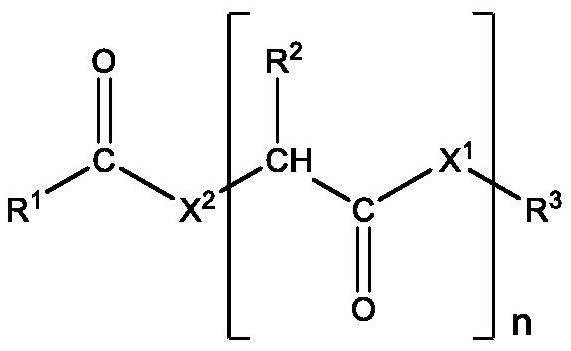A composition comprising a protein and a polyalkoxy fatty acyl surfactant
A polyalkoxy fatty acyl and surfactant technology, which is applied in the field of compositions containing proteins and polyalkoxy fatty acyl surfactants, and can solve problems such as surfactant degradation
- Summary
- Abstract
- Description
- Claims
- Application Information
AI Technical Summary
Problems solved by technology
Method used
Image
Examples
Embodiment
[0022] In the polyalkoxyaliphatic compound of formula I, R 1 A substituted or unsubstituted aliphatic group is preferred. Among substituted aliphatic groups, the preferred substituent is hydroxyl. More preferably, R 1 is an unsubstituted aliphatic group; more preferably, R 1 is an unsubstituted alkyl group. Preferably, R 1 is a linear alkyl group having 9-22 carbon atoms, preferably 10-18 carbon atoms, more preferably 10-16 carbon atoms.
[0023] Preferably, X 1 It's NH. Preferably, X 2 It's NH.
[0024] Preferably, n is 0 or 1, 2, 3, 4 or 5. More preferably, n is 0 or 1.
[0025] Preferably, R 2 Has 20 or fewer atoms; more preferably 15 or fewer atoms. Preferably, if R 2 is not hydrogen, then R 2 Contains one or more carbon atoms. Preferably, R 2 is hydrogen or unsubstituted hydrocarbyl; more preferably, R 2 is hydrogen, an unsubstituted alkyl group, or an alkyl group whose only substituent is an unsubstituted arene group. Among unsubstituted alkyl groups, m...
example 1
[0060] Prepare 600 μL of formulation in 1 mL glass vials. 100 μL was removed for t=0 analysis, and samples were then shaken sideways overnight at 200 rpm at 35°C. Measure the phase clarity of each vial and measure the size of a 100 μL aliquot by DLS. The data are shown in the table below:
[0061] Phase Transparency:
[0062]
[0063] Light scattering data, mean size (nm)
[0064]
[0065] From the light scattering data, the concentration required to keep the mean radius smaller than a certain size can be calculated:
[0066]
example 2
[0067] Example 2: Aggregation Kinetics
[0068] Experiments were performed as in Example 1, but with a set concentration of surfactant: 0.05 mg / mL (ratio 400:1). At each time point, samples were removed from the shaker and analyzed for hydrodynamic radius by light scattering. For Unreadable data, enter a value of 100.
[0069] Hydrodynamic radius.
[0070] Shaking time (hours) PS80 PS20 PO188 FM1000 control 0 7.7 7.9 7.8 8 100 0 7.7 8 7.9 7.9 100 0 8 7.9 8 8.1 100 1 7.7 7.7 9.4 7.8 7.9 1 7.4 7.7 9 7.7 8.2 1 7.6 7.4 8.9 7.6 100 2 10.3 8.2 20.8 7.6 10.3 2 8.7 8.2 14.1 7.9 9.1 2 8.6 7.9 11.7 7.9 100 4 14.5 8.6 100 8.2 12.1 4 11.9 9.4 100 8 11.7 4 14.4 8.8 100 8.1 100 6 100 10 100 9.2 13.9 6 21.3 11.3 100 8.4 16.2 6 11.5 10 100 10.4 100
[0071] This data can be fitted and used to calculate the time to reach a given radius...
PUM
| Property | Measurement | Unit |
|---|---|---|
| Number average molecular weight | aaaaa | aaaaa |
Abstract
Description
Claims
Application Information
 Login to View More
Login to View More - R&D Engineer
- R&D Manager
- IP Professional
- Industry Leading Data Capabilities
- Powerful AI technology
- Patent DNA Extraction
Browse by: Latest US Patents, China's latest patents, Technical Efficacy Thesaurus, Application Domain, Technology Topic, Popular Technical Reports.
© 2024 PatSnap. All rights reserved.Legal|Privacy policy|Modern Slavery Act Transparency Statement|Sitemap|About US| Contact US: help@patsnap.com










